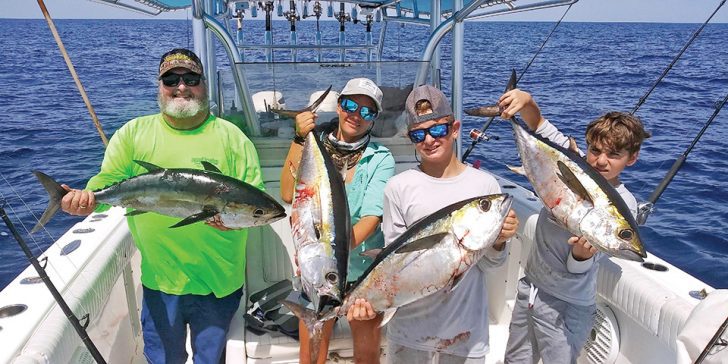The Black Fin tuna is among our most coveted offshore eaters here in South Florida and it remains an important species both recreationally and commercially. They are not the world renowned culinary gold standard for tuna, commanded by the monster bluefin and yellowfin that curcum navigate the globe. In fact the black fin is one of the smallest species in the tuna family and also has a narrow range unique to the Western Atlantic. They are highly migratory, and as the seasons change can be found from Northern Brazil all the way up the Eastern seaboard to Massachusetts. In the summer months, above the equator, they migrate to the extreme Northern portions of their range chasing increasing water temperatures as they warm to above 70 degrees.
Black Fins can be found in South Florida year round, however we are in the middle of their migratory range. The fish that we see seem to always be on their way somewhere. In the winter they are headed to the equator but in spring they travel through South Florida in force.
The fish can grow to just under 50 lbs although one that size would be rare. An average fish is about 20 inches corresponding to a weight of about 7 lbs. The all tackle record (as of this writing) according to IGFA, was caught in 2006 in Marathon, and weighed in at 49 lbs 6 oz
Black fins like some other tuna are known to travel in schools and can be observed forcing large numbers of panicked baits to the surface and pinching them between frigates and other seabirds as they dive, snap and gorge. The fish don’t spend all of their time at the surface. Researchers have documented the fish diving to over 600 ft.
Captain Danny Ramos @BlueDreamFishing, likes to start targeting black fins in the later part of the month. “If we don’t see birds right away, we’ll troll a zig zag pattern from the reef out to about 500 feet dragging cedar plugs and small feathers. Once we find the fish we’ll zero in on that depth. Tuna can be really fast. Sometimes you will find a flock of diving birds chasing the school and they’ll be moving so fast you can’t catch them. Normally if you see a big flock of diving birds, maybe 10 or more, it’s Tuna. Get out in front of them and cast a one or two once bucktail. I like either white, or blue and white. Work it fast through the school. When the fish are frenzied, it’s a reactionary bite. They just don’t want to let that bucktail get away.”
Whatever your method, blackfin tuna pull hard, are fun to target, and make great eating. Whether prepared as sashimi, grilled or fried make sure you bleed all tuna by cutting the artery below the gills. Get out there and make it happen.


